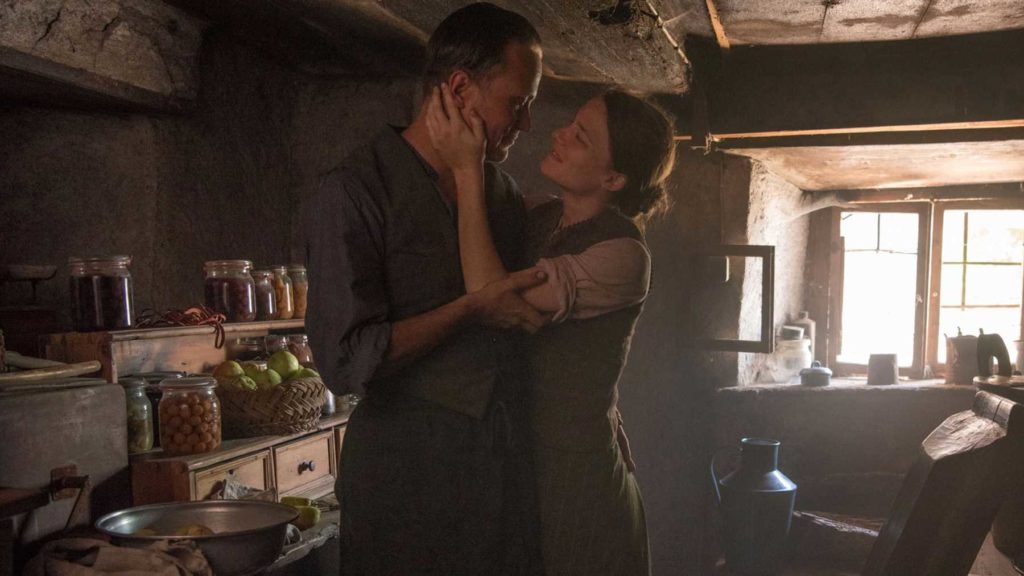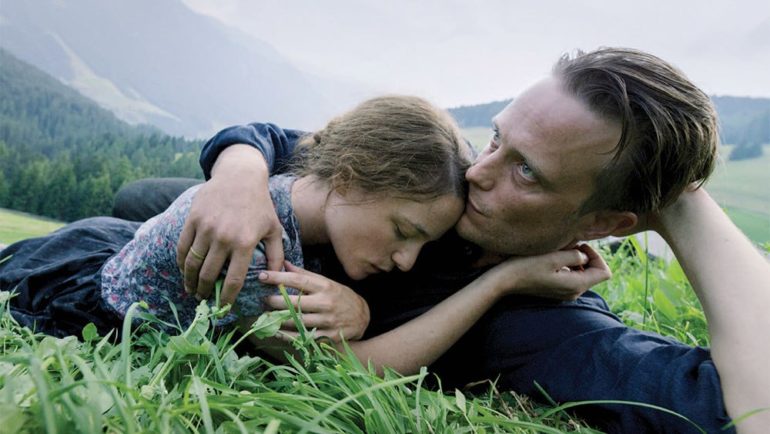Spirituality has always been a big theme in Terrence Malick’s films. Sometimes this is just latent in the hypnotic imagery of his films, such as the sumptuously shot Days of Heaven (1978), or else it is just beneath the surface of his tales of corruption and innocence like it is in Badlands (1973). At other times this religiosity is more manifest, whether depicting the universe’s beginnings in The Tree of Life (2011) or taking us on an existential odyssey through the emptiness of modern-day Los Angeles in Knight of Cups (2015), Malick always seems to be preoccupied by such themes. In A Hidden Life, Malick brings such themes to the fore, allowing them to become central to his narrative.
A Hidden Life is based upon the real-life story of the Austrian Franz Jägerstätter who was a conscientious objector during the Second World War. In the film’s opening scenes, we witness Jägerstätter’s (August Diehl) idyllic life in the Austrian mountains. We observe him harvesting crops and tilling the fields with his wife Franziska (Valerie Pachner); we watch them as they share loving, silent glances and ecstatic, affectionate kisses; we look on as they play games with their three young girls involving blindfolds, spoons and pots.
A Hidden Life unfolds with Malick’s usual laconic ease. Much time is spent on the admittedly astonishing beauty of the Austrian countryside and on life’s simple, everyday pleasures. The film is more concerned with mood and feeling above all else and while there is, as there always is with Malick, a certain rapturous beauty to the film’s early scenes, there is only so much that this can do to sustain audience interest in a three hour-long film. What plot there is in this film is rather bare: Jägerstätter due to his intransigent, Christian conscience refuses to profess an oath of loyalty to Hitler when it is demanded of him. It is a courageous act which causes his imprisonment and his family to suffer his absence and their community’s ire. From there the film strolls leisurely through to its inevitable conclusion.

While watching A Hidden Life I couldn’t help think of Martin Scorsese’s Silence (2016), another historically based film which is similarly concerned with the cost of unwavering faith and irrepressible convictions. One of the things which sustains Scorsese’s magisterial film (among others) is the questions it asks of its protagonist. Not only is Sebastião Rodrigues’ devotion to his faith the direct cause of human suffering, Scorsese also makes us aware of the narcissism which contributes to Rodrigues’ obstinance. Of course, the circumstances are entirely different. The case of Franz Jägerstätter is admirable and indisputably worthy of celebration but there is nothing in this film to suggest that Malick is the filmmaker to do it. His usual meditative, airy detachment from his characters does nothing to service Jägerstätter’s story and rather than feel repulsed by his torment at the hands of Nazi prison officers, I felt predominantly disinterested – Malick’s snail-paced, visually repetitive series of images, in this instance, had already alienated me from the film before these events begin. Whatever empathy we do feel in such scenes are entirely dependent upon our knowledge of the historical reality rather than resulting from the film itself. In one ill-judged scene for example, Malick resorts to a POV shot when Jägerstätter is being beaten and the visuals are more reminiscent of video games than cinema; such scenes suggest a director unsure of the material in their hands.
Malick has never been a visceral filmmaker and his instinct is for the contemplative rather than the hard-hitting, emotionally affecting. Malick adheres as stubbornly to his principles as does his protagonist but, in this instance, you wonder what Malick’s contemplating. Unlike in Silence, the situation is morally black-and-white and Malick’s sublime imagery often works best when its dreamlike, Edenic quality is being offset against narratives of temptation and corruption such as it is in Badlands or Days of Heaven. There is no such contrast here. In case anybody was left wondering what the film is about (trust me, they weren’t) or where the title comes from, the film ends with a quote by George Eliot to tell us that “the growing good of the world is partly dependent on unhistoric acts; and that things are not so ill with you and me as they might have been, is half owing to the number who lived faithfully a hidden life, and rest in unvisited tombs.” It’s as if Malick, after three hours, is unsure if you’ve taken what he wanted you to take from the film.
A Hidden Life is a perfect example of an auteur’s signature style simply being irreconcilable with the story that it’s hoping to tell. Malick began the previous decade with The Tree of Life, a film which was greeted with critical acclaim and has since go on to rank highly on many best of the decade lists. Since then however, critical reception has tended to be either lukewarm or downright negative towards his films (this being a rather surprising exception). Whatever their flaws (and there are many), these previous films are at least interesting auteur pieces that I struggle to imagine any other filmmaker making. A Hidden Life is the first film in Malick’s oeuvre that I felt entirely disinterested by and, what is worse is that I could imagine it being a much better film in different hands – it would have been shorter at least.

